
Cattails are a common sight in swampy or moist areas near lakes and streams and are easily recognizable by their brown flower stalks and long leaves. While you will probably never see cattail for sale as a vegetable or medicinal herb, it is a valuable plant for food, medicine, and utilitarian uses.
Eating Cattails
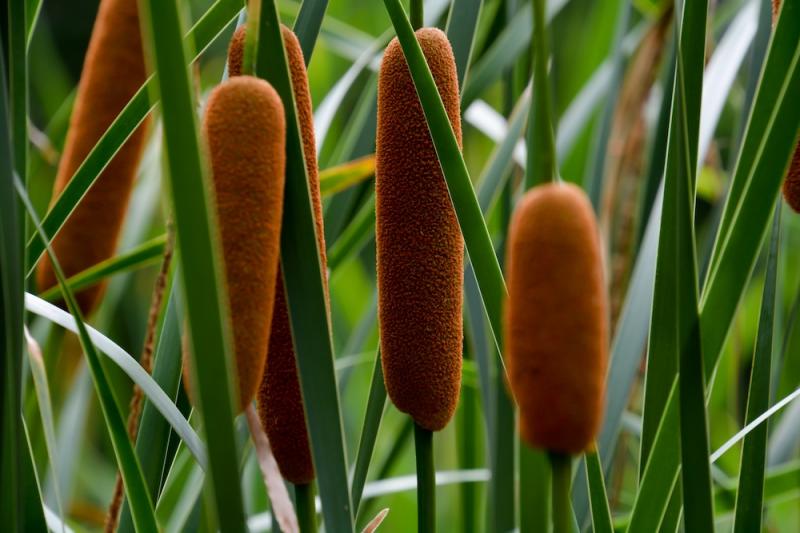 Cattail really shines in the ways it can be used as a food. My favorite part is the young shoots and stalks. When the plant is under two feet tall, I grab the leaves and pull on them. At the bottom, you’ll find a white, fleshy part that is crunchy,sweet, and easy to eat. This is also true of the horn-shaped sprouts that grow from the rootstalks at the base of the plant. You can eat these either cooked or raw.
Cattail really shines in the ways it can be used as a food. My favorite part is the young shoots and stalks. When the plant is under two feet tall, I grab the leaves and pull on them. At the bottom, you’ll find a white, fleshy part that is crunchy,sweet, and easy to eat. This is also true of the horn-shaped sprouts that grow from the rootstalks at the base of the plant. You can eat these either cooked or raw.
The other parts I’ve eaten are the pollen and the immature female flowers. Cattail has both male and female flowers. The female flowers are green or light brown in the spring and turn into the distinctive darker brown structure at the top of the plant which develops later in the year. The male flowers grow above the female flowers and are visible in the spring.
When the male flowers are blooming you can shake the stalks and see the yellow pollen coming off of the male flowers. This pollen is fairly easy to collect. If you grab a plastic bag and hold it over the top of the stalk you can shake the stalk and knock the pollen off into the bag.
The pollen can be used to extend flour. Just mix equal halves of pollen and flour. I’ve used this to make pancakes or waffles and they were delicious.
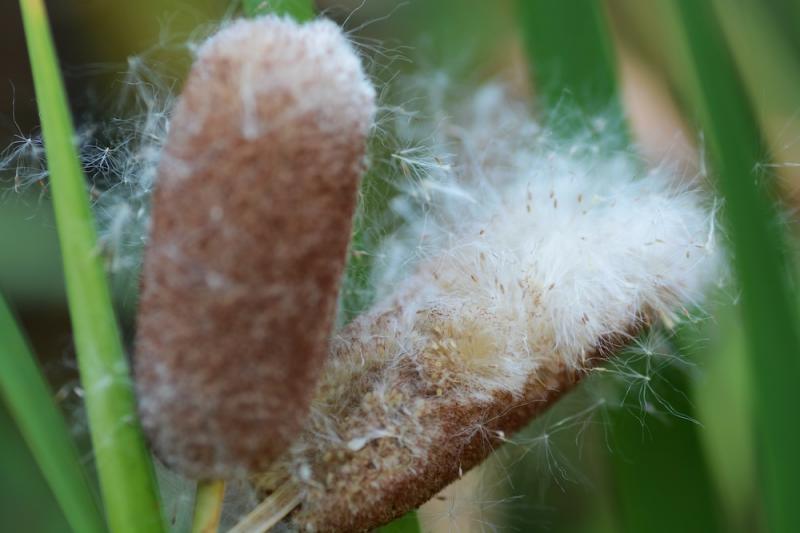 When the male flowers are producing pollen you can harvest the green or light brown female flowers by cutting them off the top of the stalk. When I ate them I boiled them for just a few minutes (like boiling fresh corn on the cob) and ate the flowers the same way you eat corn on the cob. You can even add a little butter and salt to enhance the flavor. They were pretty good, too.
When the male flowers are producing pollen you can harvest the green or light brown female flowers by cutting them off the top of the stalk. When I ate them I boiled them for just a few minutes (like boiling fresh corn on the cob) and ate the flowers the same way you eat corn on the cob. You can even add a little butter and salt to enhance the flavor. They were pretty good, too.
The parts I’ve never tried eating are the roots and rhizome because I’ve never bothered to bring a shovel with me to dig them up. The roots are a rich source of both starch and protein so they have a lot of nutritional value. From what I’ve read, the best way to use them is to carefully wash them, then mash them up in a bowl of water to release the starch into the water. You can then allow the water to evaporate and use the starch-like flour.
If you want more tips on eating cattails from someone with even more practical experience, I recommend Foraging the Mountain West by Thomas J. Eipel and Kris Reed. It’s a great guide to many other wild edibles, too.
Using Cattail as Medicine
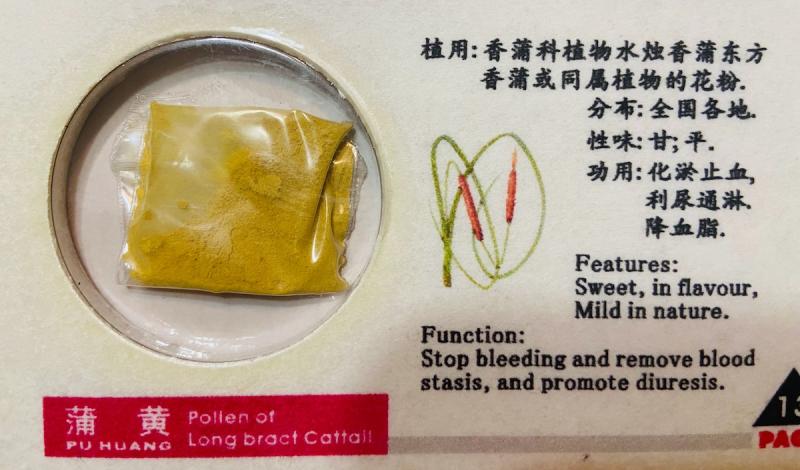 While cattail doesn’t have as many medicinal uses as it has food uses, there are some ways you can use it for healing. There is a mucilaginous sap that you can find at the base of the leaves as you pull them away from the stalks. It can be applied just like aloe vera to burns, wounds, and skin irritations. It helps to ease the pain and also acts as a mild styptic to stop bleeding in wounds. The crushed ripe (brown) flowers can also be mashed and made into a poultice for burns and cuts.
While cattail doesn’t have as many medicinal uses as it has food uses, there are some ways you can use it for healing. There is a mucilaginous sap that you can find at the base of the leaves as you pull them away from the stalks. It can be applied just like aloe vera to burns, wounds, and skin irritations. It helps to ease the pain and also acts as a mild styptic to stop bleeding in wounds. The crushed ripe (brown) flowers can also be mashed and made into a poultice for burns and cuts.
Cattail pollen is used in traditional Chinese medicine as a styptic to heal bleeding associated with excess heat. It is considered sweet in taste and neutral in energy. It affects the spleen, heart, liver, and pericardium meridians. It’s used to treat bleeding from physical trauma (injuries), but also nosebleeds, heavy menstrual bleeding, and vomiting of blood. It’s also used for chest pain, excessive menstrual discharge, and delayed menstruation. It is also recommended to avoid taking it during pregnancy.
Because cattail pollen is sweet and neutral, it tends to act as a slow tonic for these problems, not as something for rapid symptomatic relief. And like most TCM herbs, it is usually used as part of a formula. I haven't tried using cattail pollen as a medicine, but it would be easy enough to gather some of it and try it out.
Utilitarian Uses for Cattail
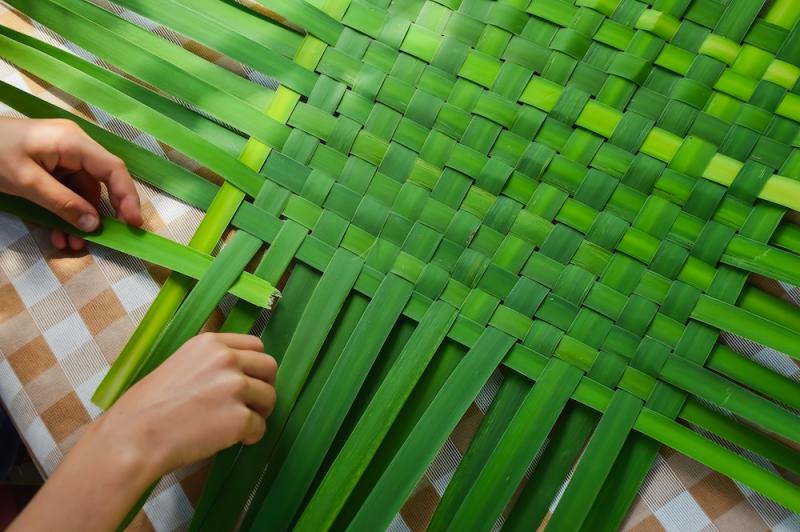 Cattail is one of the four plants survivalist Tom Brown called a survival supermarket. It has many uses in outdoor survival situations. The leaves can be used to weave mats and can also be used along with the stalks to thatch survival shelters. The flower stalks can be dipped in fat to create a torch. And with a lot of practice, the stalks could be used as hand drills for starting fires.
Cattail is one of the four plants survivalist Tom Brown called a survival supermarket. It has many uses in outdoor survival situations. The leaves can be used to weave mats and can also be used along with the stalks to thatch survival shelters. The flower stalks can be dipped in fat to create a torch. And with a lot of practice, the stalks could be used as hand drills for starting fires.
The downy seeds from the brown female flowers also make good tinder for starting fires. They are also a good insulating material. I read once about a guy who stuffed a jacket with them to insulate himself for winter weather.
Cattail as an Emotional Remedy
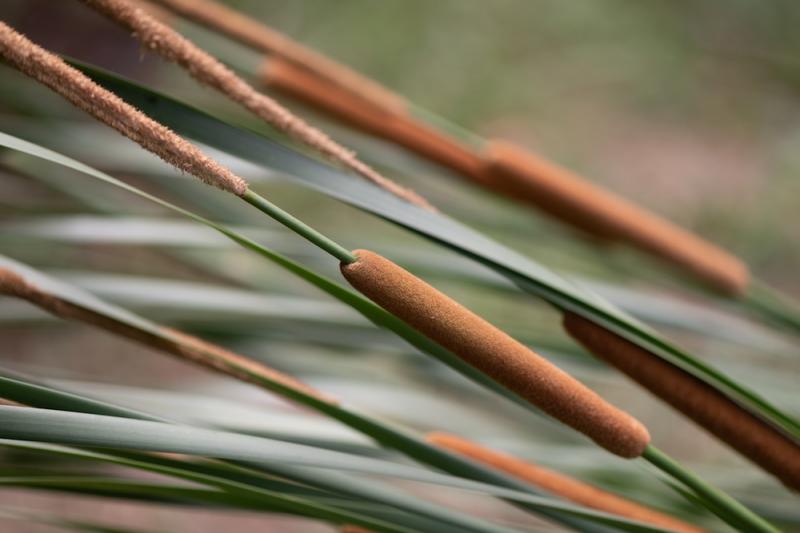 As I was writing this article I was thinking about the signatures of cattail and what the plant might represent emotionally. Like the iris, cattail grows in a swampy environment. Iris helps someone rise above the things that bog them down and look upwards towards the light. It occurred to me that cattail would have a similar energy. It grows straight and tall, being firmly rooted even in a swampy environment.
As I was writing this article I was thinking about the signatures of cattail and what the plant might represent emotionally. Like the iris, cattail grows in a swampy environment. Iris helps someone rise above the things that bog them down and look upwards towards the light. It occurred to me that cattail would have a similar energy. It grows straight and tall, being firmly rooted even in a swampy environment.
So, I did a quick bit of research and found two companies that make a flower remedy from catnip pollen, which comes from the male flowers. Both indicated that the remedy helps one stand tall and have the courage to be true to yourself. This is similar to mullein, which also helps you stand tall and be true to your inner voice or conscience.
Cattail, however, seems more suitable for the person who needs to have the courage to be true to their own convictions and not be swayed by their environment or the people around them. It helps you be firmly rooted within yourself and express who you are and what your own purpose is.
I hope this introduction to the many uses of cattail inspires you to try using some. Just make sure it’s not growing in polluted water if you’re going to harvest the shoots or roots for food.
Downloads
Steven's Articles
-

-
The Evidence for Berberine
A yellow alkaloid found in traditional infection-fighting…
-

-
The Sensible Use of Caffeinated Herbs
Kola nuts, guarana, and yerba mate and other herbs…
-

-
The Health Benefits and Problems with Coffee
This popular caffeinated beverage can be beneficial…
October
-

-
Understanding Caffeine & Cellular Adaptation
Preserving the power of caffeine's buzz and the…
September
-

-
Horseradish
A pungent spice for aiding protein metabolism…
-

-
Banaba or Crepe Myrtle
A beautiful tree from Southeast Asia whose leaves…
August
-

-
Monkeyflowers
Flower essences to help see ourselves more clearly…
-

-
Mariposa Lilies
Strengthening the bond between mother and child…
-

-
The Noble Bay Leaf
A common kitchen herb for aiding digestion and…
-

-
Epimedium: Horny Goat Weed
A circulatory stimulant and kidney yang tonic…
July
-

-
The Medicinal and Nutritional Benefits of Apricots
A nutritious fruit and valuable medicinal seed for coughs
-

-
Dogwoods
Asian dogwood is used to stop excessive discharge,…
June
-

-
Neem: The Village Pharmacy
A popular Ayurvedic remedy for dental and immune…
-

-
Spilanthes: The Toothache Plant
A traditional remedy for teeth and gums, as well…
-

-
Forsythia
An anti-inflammatory, fever-reducing, and infection fighting herb

